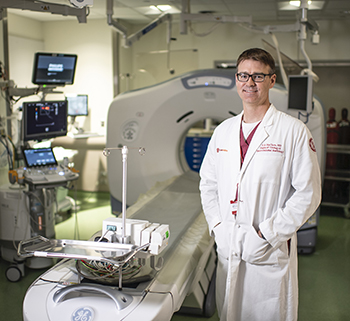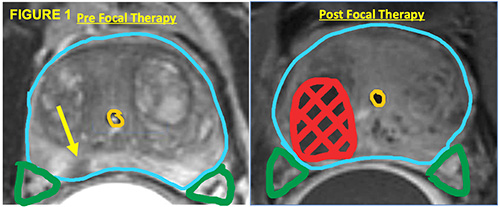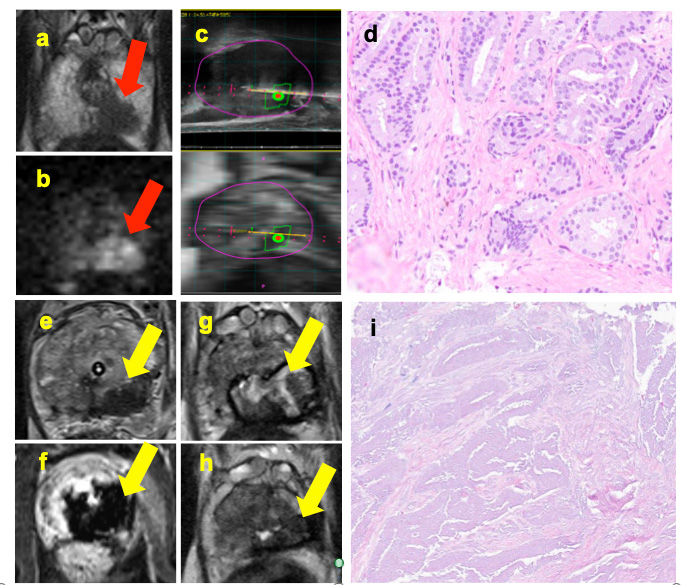Prostate cancer is the most common cancer in men, with a disease course that differs radically. In men with low-risk prostate cancer – grade group 1 disease – the clinical recommendation is close monitoring using active surveillance. Therapeutic approaches for men with intermediate risk prostate cancer – grade group 2 or 3 – are directed at the whole gland, notwithstanding significant variations in cancer volume, location, and other risk factors. Prostatectomy or radiotherapy with or without systemic therapy is associated with erectile dysfunction in more than half of patients, and up to 10 percent of men will experience long-term stress urinary incontinence.
Dr. Timothy McClure
“A newer approach to prostate cancer treatment for men at intermediate risk is MRI-guided focused ultrasound focal therapy where we target just the area of cancer in the gland itself rather than treating the whole gland,” says Timothy D. McClure, MD, a urologist and interventional radiologist and expert in image-guided therapy in the Divisions of Urologic Oncology and Interventional Radiology at NewYork-Presbyterian/Weill Cornell Medical Center. Dr. McClure brings a unique background to the Department of Urology and the minimally invasive treatment of urologic disease as he is also board certified in interventional radiology and diagnostic radiology.
“Prostate cancer treatment for localized disease has evolved as imaging techniques have improved. We can now use MRI to identify areas in the prostate that contain clinically significant prostate cancer, allowing us to focally treat these areas,” says Dr. McClure. “This helps us preserve surrounding nerves and muscles, which helps keep sexual and urinary function intact after treatment. Focal therapy allows us to eliminate the cancer that’s putting patients at intermediate risk and bring them back down to low risk where we can then continue to monitor with active surveillance, all while minimizing side effects of treatment.”
Focal therapy is the concept where the focus of prostate cancer identified on imaging (yellow arrow on above T2 axial image of the prostate) can be focally ablated (red shading on above T1 post contrast axial image of the prostate) preserving the remainder of the prostate (blue boundary), the neurovascular bundles (green), and the urethra (orange circle).
Novel technologies proficient in focal ablation utilize both thermal and non-thermal energy sources. High-intensity focused ultrasound has been shown to be safe and to effectively ablate malignant prostate tissue in early phase clinical trials. However, most trials of high-intensity focused ultrasound have occurred in single centers, primarily with patients who have low-risk prostate cancer and performed under ultrasound guidance without direct monitoring in real time.
"Focal therapy allows us to eliminate the cancer that’s putting patients at intermediate risk and bring them back down to low risk where we can then continue to monitor with active surveillance, all while minimizing side effects of treatment." – Dr. Timothy McClure
“The concept of focal therapy is still in its early phases from a management perspective, so it is very important to enroll patients in either well-defined, well-established prospective registries or clinical trials,” says Dr. McClure, who participated in a multicenter, phase 2b study of this approach for which Weill Cornell Medicine served as one of the eight trial sites. The trial was conducted in men aged 50 years and older with intermediate-risk prostate adenocarcinoma visible on MRI and confirmed on combined MRI-targeted and systematic biopsy. None of the patients had received previous treatment for their prostate cancer. A total of 101 patients with a median age of 63 years and a median concentration of prostate-specific antigen of 5·7 ng/mL were treated with MRI-guided focused ultrasound. Most cancers were grade group 2. Study findings, which were published in the July 2022 issue of The Lancet Oncology, showed:
- At 24 months, 78 out of 89 men (88 percent) had no evidence of grade group 2 or higher prostate cancer in the treated area
- No grade 4 or grade 5 treatment-related adverse events were reported and only one grade 3 adverse event (urinary tract infection) occurred
- There were no treatment-related deaths
“This study suggests that treating patients with focal therapy improved sexual and urinary function when compared to historical reported outcomes with surgery or radiation,” says Dr. McClure. “But while focal therapy is a good treatment option for certain patients, it is not necessarily a cure per se, because one limitation of this approach is that the remaining prostate is left untreated and at risk for developing cancer. At two years, 40 percent of the patients in this study went on to develop prostate cancer in the area that was not treated. Clearly, we need to optimize focal therapy and determine how to manage the remaining prostate that wasn’t treated.”
A 73-year-old male with an elevated PSA and a prostate MRI that showed a focus of T2 hypointensity (a, red arrow) and restricted diffusion (b, red arrow) who underwent MRI-US transperineal biopsy (c). Pathology demonstrates intermediate risk prostate cancer only in the area of prostate correlating with MRI abnormality (d). Patient underwent focal IRE. Immediate post IRE MRI shows focus of T2 hypointensity (e) and an area of non perfusion (f) in the IRE ablation zone. Progressive changes seen on prostate MRI at 3 months (g) and 12 months (h) post ablation show retracting ablation zone (yellow arrows). MRI-US transperineal biopsy at 12 months post IRE showed no evidence of cancer (i).
Next Step: A Combination Therapy
Dr. McClure and Dr. Himanshu Nagar of Radiation Oncology are currently running a clinical trial called RTIRE (Feasibility Study of Radiation Therapy and IRreversible Electroporation for Intermediate Risk Prostate Cancer) that combines radiation and focal therapy. “We’re focally treating intermediate risk cancer which has been identified on imaging,” explains Dr. McClure, “and we then treat the whole prostate with a much lower dose of radiation to ‘sterilize’ the remaining prostate. The hope is that by doing this, we are able to reduce the rate of recurrence that happens after treatment with just focal therapy. It also reduces the side effect profile that occurs when giving higher doses of radiation.”
The year-long study, which is currently recruiting patients, employs prostate specific membrane antigen (PSMA) PET imaging, a breakthrough diagnostic approach that uses a radioactive imaging agent that binds to prostate cancer cells, helping to localize them. “We’re hoping that we can use this imaging technique to avoid subsequent biopsies that may be required after patients have focal therapy,” says Dr. McClure.
In describing Weill Cornell Medicine’s program in developing novel approaches to manage patients with prostate cancer, Dr. McClure stresses the close collaboration of the urology, radiology, radiation oncology, and pathology departments. “Weill Cornell Medicine is unique in that it’s among the few places in the country that offers patients multiple modalities for focal therapy,” says Dr. McClure. “Every patient is different, and each type of focal therapy has its own associated risks and limitations. Not all parts of the prostate can be treated equally with an ablative or focal therapy approach. Some tumors are in areas where one focal therapy won’t work, and other tumors are in an area where other focal therapy treatments will work.”
“Our goal is to identify ideal candidates for this approach so they can have the best treatment option while minimizing the side effect profile,” adds Dr. McClure. “At the same time, we are striving to advance the field by participating in and developing clinical studies to identify patients best suited for each treatment in order to optimize their prostate cancer care.”






